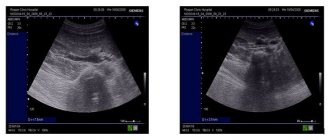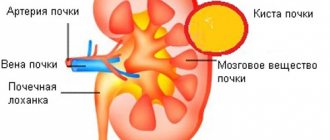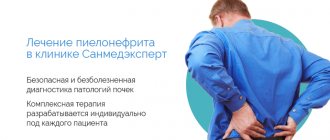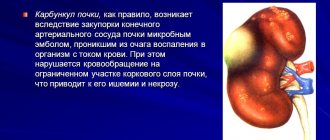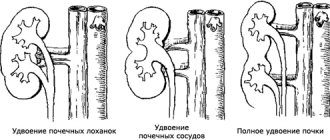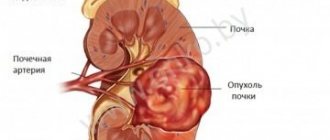Nephropexy is a surgical intervention to fix a prolapsed kidney. This intervention is carried out in case of nephroptosis, when the kidney not only descends, but also displaces. The operation is performed either by laparoscopy or by open access.
It is important to understand that this procedure is not indicated for all patients diagnosed with an abnormal location of the kidney. We will look at what nephropexy is in more detail below. Now let's figure out who this operation is indicated for.
Indications
The following conditions require specialist help:
- If the patient complains of constant pain in the pelvis, abdomen, lower back.
- When the kidney interferes with the flow of urine, becoming an obstacle to the ureter. This happens when an organ changes its position, turning around its axis.
- Nephroptosis causes renal hypertension.
- The kidney drops very low, occupying an anatomically incorrect place in the lower abdomen.
- The renal pelvis is dilated (pyelectasia).
- If, when the kidney prolapses, chronic pyelonephritis constantly causes problems.
- Presence of stones in the organ.
The choice of type of nephropexy will depend on the condition of the patient and how advanced the pathology is.
If the kidney descends quite significantly, then it is recommended to install a mesh-type prosthesis. In the presence of serious diseases of the heart, blood vessels, metabolism, and the like, abdominal surgery is indicated rather than laparoscopy.
Indications and contraindications
Indications
- bending of the ureter or rotation of the kidney with pinching of blood vessels;
- descent of the kidney into the pelvis;
- severe pain and dysfunction;
- frequent inflammatory processes;
- hypertension due to nephroptosis;
Contraindications
- acute inflammatory or infectious processes;
- some blood diseases;
- concomitant diseases in the stage of decompensation (cardiovascular, diabetes, etc.);
- prolapse of internal organs.
Methodology
Nephropexy - what is it in the case of abdominal surgery? The patient is given general anesthesia. The surgeon then makes layer-by-layer incisions into the skin. Double sutures are placed on the kidney, its lower segment. There are two of them and they are called mattress ones.
Thanks to this technique, the fixation will be strong and reliable. In order for the organ to quickly take root in the tissues located in the space behind the peritoneum, part of the fat layer is removed between them - a small flap of adipose tissue (capsule) is excised. The correct position is selected for the kidney. It is sutured to the psoas muscle (quadratus muscle).
Source: ppt-online.org
Laparoscopy
Surgery to lower the kidney using laparoscopy is the most common. Small punctures are made in the skin, so the recovery process is faster than with abdominal surgery. And the risk of infection is much lower. The patient is given general anesthesia. Endotracheal anesthesia is chosen. If there are contraindications, then epidural anesthesia is used. The injection is given in the spine area and the lower parts of the body become insensitive.
The operation for kidney prolapse is carried out under the control of the patient’s condition. Urine should not change either in consistency or color. To do this, a special catheter is inserted into the ureter. To provide the necessary space in the abdominal cavity, gas (pneumothorax) is injected during the first puncture.
This hole helps monitor the progress of the operation using a special camera. The patient is then turned onto his side. Before this he was lying on his back. The doctor makes a few more punctures (no more than four) and introduces the instruments necessary for the operation. The surgeon then isolates the ureter and that segment of the kidney, which is called the upper one. Scissors are used to separate the tissue located around the kidney.
Using a semicircular needle, the kidney is tied with special threads that will never dissolve to the quadratus muscle. Next, the needle is inserted into the lower punctures and thanks to this the entire organ becomes securely fixed. It happens that the kidney is placed, as it were, in a mesh - a prosthesis. Then the fixation is carried out through it.
The operation to lower the kidney requires a careful examination of the organ, stopping bleeding from vessels damaged during incisions. The doctor reduces the pressure created in the peritoneum. Drainage is also carried out. The tubes through which the instruments were inserted are removed from the incisions. They are called trocars. The wounds formed during punctures are sutured or a bandage with an antiseptic is applied to them. The catheter should remain in the ureter for some time.
We looked at how the problem of kidney prolapse is eliminated: surgery, and nothing else! Let us remember that for intervention, symptoms are needed, not just X-ray data. Please note that it is impossible to make a diagnosis using ultrasound.
How does the procedure work?
Open access - after making a layer-by-layer incision of the skin, subcutaneous tissue, and surrounding tissues, the kidney is isolated, moved to a physiological position and fixed in this position using a muscle flap cut from the surrounding muscle tissue, one end of which is sutured to the kidney capsule, and the other to the surrounding fabrics. At the same time, the necessary natural mobility of the kidney is preserved. Drains are installed to drain interstitial fluid and ichor. The wound is sutured in layers.
Laparoscopic access – a camera and instruments are inserted through 4 holes on the anterior abdominal wall. Under visual control, the kidney is isolated, placed in the desired position, the capsule is fixed with sutures, peritoneum and muscle tissue. Installation of drainage is required.
The duration of the operation is from 40 minutes to 1.5 hours.
Complications
An experienced surgeon can perform the intervention so that complications do not arise. But still, no one has canceled the human factor and the individual reaction of the body.
The following complications are possible:
- The kidney capsule is damaged. Pain appears and the place where the kidney is located swells. Often, repeat surgery is not required. Conservative therapy is carried out. And bed rest is required for about two weeks.
- Hematomas. Internal hemorrhages are not uncommon. They often disappear on their own.
- Traumatization of nerve endings. Nerve damage can occur in many different ways. Their degree determines whether the nerves can recover over time or not.
- Incorrect fixation of the organ. An operation to prolapse the kidney may be unsuccessful due to the fact that during fixation the anatomical position of the organ is disturbed. The kidney will be either lower or higher. If the degree of deviation is significant, additional intervention must be carried out to correct the error.
- Relapse. Relapse usually occurs in the case of laparoscopy.
Why is it better to do nephropexy at the Swiss University Hospital?
- Our clinic is one of the first to begin performing nephropexy using a gentle method; over more than 20 years, about 7 thousand operations have been performed.
- We employ experienced surgeons of the highest category, recognized experts, known both in the country and abroad, each doctor is fluent in all techniques in his specialization.
- We can undergo a comprehensive examination, including all the necessary diagnostic methods: patients have access to modern expert-class diagnostic equipment and our own laboratories.
- During surgery, we use modern techniques and technologies, which allows us to minimize the development of complications.
- We were one of the first to begin performing simultaneous (simultaneous) operations; during one surgical intervention, we can get rid of several concomitant pathologies that require surgical treatment.
Rehabilitation
It takes a maximum of three weeks to restore general health if abdominal surgery was performed. Surgery for nephroptosis using the laparoscopic method involves the patient being in the hospital under observation for about a week. You can't get up for several days. The position is chosen as follows: the legs are raised high relative to the level of the head - 25 cm.
If difficulties arise with urination, a catheter must be left in the ureter. To ensure defecation occurs without straining, the patient is prescribed laxatives.
A course of antibiotics is required to prevent infection. The day after surgery, you may experience chills, as well as pain at the incision or puncture sites. Discomfort is felt in the shoulders and neck. The kidney will gradually recover over about three years.
Strict restrictions are needed for the first six months after surgery. Although the prolapse of the kidney has been eliminated, the patient must follow the following recommendations:
- do not lift heavy objects or engage in exhausting physical labor;
- forget about sexual intercourse;
- food should be gentle and easily digestible to avoid bloating.
You should prepare for the operation. You need to rest more, take vitamins. Then the body can easily cope with surgery. Kidney prolapse surgery affects each patient differently. Some people get anesthesia without problems, but others have a hard time coming out of it. The complaint is usually that after waking up the head hurts very much.
According to patients, the current laparoscopic nephropexy is much better than the operation that was offered at the beginning of this century. Previously, abdominal surgery was practiced. In addition, today there are private clinics where the medical staff makes patients feel comfortable. And this is very important, especially during long-term hospitalization. Moreover, laparoscopy is sometimes performed free of charge (insurance).
Professional specialists ensure fairly rapid recovery without significant complications.
Quite often, women who are planning a pregnancy decide to undergo such an operation. After the intervention, it is necessary to postpone attempts to conceive a child for a year, but then the chances of a successful pregnancy and childbirth without problems increase significantly.
List of published works on the topic of laparoscopic nephropexy
- Puchkov K.V., Ivanov V.V.. Technology of dosed ligating electrothermal effects at the stages of laparoscopic operations: monograph. - M.: ID MEDPRACTIKA, 2005. - 176 p.
- Puchkov K.V., Kolesov V.Yu., Kolesnikova N.O. Radiation diagnostics today - search, solution, prospect // Magnetic resonance imaging in a multidisciplinary clinical hospital. - Ryazan: GUZ ROKB, 2004.- P.3-7.
- Puchkov K.V., Filimonov V.B., Vasin R.V., Dmitrienko S.V. Laparoscopic approach in the surgical treatment of nephroptosis // Endoscopic surgery. – 2006.-T.12, No. 2. – P.110.
- Puchkov K.V., Filimonov V.B., Vasin R.V., Dmitrienko S.V. Surgical treatment of nephroptosis using laparoscopic access // Endoscopic surgery. – 2006.-T.12, No. 1. – P.48-49.
- Puchkov K.V., Filimonov V.B., Vasin R.V. Minimally invasive technologies in the surgical treatment of nephroptosis // Minimally invasive methods of diagnosis and treatment in modern urology: abstract. report 3rd international Conf. - St. Petersburg, March 2-3. 2006 – St. Petersburg, 2006. -P.56-57.
- Puchkov K.V., Filimonov V.B., Vasin R.V. Algorithm for the optimal installation of manipulation trocars during laparoscopic operations on the retroperitoneal organs using modified intravenous excretory urography, using a “tag” // Minimally invasive methods of diagnosis and treatment in modern urology: abstract. report 3rd international Conf. - St. Petersburg, March 2-3. 2006 – St. Petersburg, 2006. -P.55-56.
- Puchkov K.V., Filimonov V.B., Vasin R.V. Laparoscopic access in the surgical treatment of benign diseases of the retroperitoneal organs // Current issues of modern surgery. Regional (Southern Federal District) scientific-practical. conf. surgical doctors, Nalchik, May 26-27, 2006 - Nalchik, 2006.- pp. 274-276.
- Puchkov K.V., Filimonov V.B., Vasin R.V. Method of preoperative calculation of optimal installation sites for ports during laparoscopic operations on retroperitoneal organs // Current issues of modern surgery. Regional (Southern Federal District) scientific-practical. conf. surgical doctors, Nalchik, May 26-27, 2006 - Nalchik, 2006.- pp. 276-278.
- Puchkov K.V., Filimonov V.B., Vasin R.V. Experimental study of the reaction of the histion system to pexy of a polypropylene mesh to the kidney // Current issues of modern surgery. Regional (Southern Federal District) scientific-practical. conf. surgical doctors, Nalchik, May 26-27, 2006 - Nalchik, 2006.- pp. 278-279.
- Puchkov KV, Filimonov VB, Vasin RV, Vasin IV Laparoscopic access in surgical treatment of malignant diseases of urogenital organs // Abstracts of The 10th World Congress of Endoscopic Surgery, 13-16 September, 2006, Berlin. – P.298.
- Puchkov K.V., Filimonov V.B., Vasin R.V., Vasin I.V. Surgical treatment of nephroptosis using a polypropylene implant: experimental and clinical rationale // Trends, strategies and development of medical care in a multidisciplinary hospital: collection. scientific tr. – Ryazan, 2007. – pp. 241-244.
- Puchkov K.V., Filimonov V.B., Vasin R.V. Algorithm for optimizing laparoscopic access during operations on retroperitoneal organs // Trends, strategies and development of medical care in a multidisciplinary hospital: collection. scientific tr. – Ryazan, 2007. – pp. 247-249.
- Puchkov K.V., Filimonov V.B., Vasin R.V., Vasin I.V. Experimental study of the reaction of living tissues to the fixation of a polypropylene mesh to the kidney // Endoscopic surgery. – 2007.-T.13, No. 1. – P.67.
- Puchkov K.V., Filimonov V.B., Vasin R.V. Method of nephropexy using a prolene implant using laparoscopic access // Endoscopic surgery. – 2007.-T.13, No. 1. – P.68.
- Puchkov K.V., Filimonov V.B., Vasin R.V., Vasin I.V. Evaluation of the histological picture with various methods of fixing a polypropylene mesh to the kidney in an experiment // Minimally invasive methods of diagnosis and treatment in modern urology. Materials of the IV International Scientific and Practical. conf. – St. Petersburg, 2007.- pp. 58-59.
- Puchkov K.V., Filimonov V.B., Vasin R.V. A method of surgical treatment of nephroptosis using a polypropylene implant using laparoscopic access // Minimally invasive methods of diagnosis and treatment in modern urology. Materials of the IV International Scientific and Practical. conf. – St. Petersburg, 2007.- pp. 105-106.
- Puchkov K.V., Filimonov V.B., Vasin R.V., Vasin I.V., Ivanov V.V. Morphological features of the interaction of a polypropylene implant with the kidney and surrounding tissues (results of an experimental study) // Endoscopic surgery. – 2007.-T.13, No. 2. – P.55-61.
- Filimonov VB, Puchkov KV, Vasin RV, Vasin IV Experimental investigation of tissues reaction upon mesh, fixed to kidney and safety of prolene implant, fixed to kidney, muscles and periosteum // Abstracts book of the 15th EAES Congress 2007, 4- July 7, 2007, Athens, Greece. – P.204.
- Puchkov K.V., Filimonov V.B., Vasin R.V., Rodichenko D.S. Method for preoperative calculation of optimal installation sites for manipulation trocars during laparoscopic operations on retroperitoneal organs // Endoscopic surgery. – 2007.-T.13, No. 5. – P.17-24.
- Puchkov K.V., Filimonov V.B., Vasin R.V. Symptomatic nephroptosis - diagnosis and determination for nephropexy with a polypropylene implant using laparoscopic access // First Russian Congress on Endourology. - Mat. Congress. - Moscow, June 4-6, 2008 - pp. 323-324.
- Puchkov KV, Filimonov VB, Vasin RV A way of surgical treatment of nephroptosis with the application of polypropylene implant via laparoscopic intervention // Abstracts book of the 16th EAES Congress 2008, 11-14 July, 2008, Stockholm, Sweden. – P.208.
- Puchkov KV, Filimonov VB, Vasin RV Laparoscopic access in surgical treatment of the nephroptosis // Abstracts of The 11th World Congress of Endoscopic Surgery, September 2-5, 2008, Yokohama, Japan. – P.363.
- Puchkov K.V., Filimonov V.B., Vasin R.V., Vasin I.V. Polypropylene implants - a solution to the problem of pelvic prolapse with connective tissue dysplasia and stress incontinence // Problems of reproduction. – 2008.- (special issue). – P.120-121.
- Puchkov K.V., Filimonov V.B., Vasin R.V., Rodichenko D.S. Method of optimal installation of manipulation trocars during laparoscopic operations on retroperitoneal organs // Bulletin of Emergency Medicine (Scientific and practical journal of the Association of Emergency Medical Doctors of Uzbekistan). – 2008.- No. 3. – P.19-26.
- Pat. 2342095 RF MPK8 A61 B17/94. Method of laparoscopic nephropexy / K.V. Puchkov, V.B. Filimonov, R.V. Vasin.- No. 2006132975/14; appl. 09.14..2006; publ. 09/27/2008, Bulletin 18.
- Vasin R.V., Puchkov K.V., Filimonov V.B. Surgical treatment of nephroptosis // Moscow Surgical Journal. – 2009.- No. 1. – P.51-61.
- Puchkov KV, Filimonov VB, Vasin RV Laparoscopic nephropexy by a polypropylene implant via different techniques: short-term and postponed results of treatment // Abstracts book of the 17th EAES Congress 2009, 17-20 June, 2009, Prague, Czech Republic . – P.230.
- Puchkov KV, Filimonov VB, Vasin RV, Vasin IV Polypropylene implants as the treatment decision for patients with pelvic prolapses, connective tissue displasia and stress incontinence // Abstracts book of the 17th EAES Congress 2009, 17-20 June, 2009, Prague , Czech Republic. – P.96.
- Puchkov K.V., Filimonov V.B., Vasin R.V. Laparoscopic access during operations on the organs of the retroperitoneal space: a method of preoperative calculation of the optimal installation sites for ports // Endoscopic surgery. – 2009.-T.15, No. 1. – P.220-221.
- Puchkov K.V., Filimonov V.B., Vasin R.V. Long-term results of treatment of unoperated and operated patients with symptomatic nephroptosis // Almanac of the Institute of Surgery named after. A.V. Vishnevsky. T5, No. 1 - 2010. “Materials of the XIII Congress of the Society of Endoscopic Surgeons of Russia.” – Moscow, 2010. – P. 165-166.
- Puchkov K.V., Andreeva Yu.E., Dobychina A.V. Experience in performing simultaneous operations in surgery, urology and gynecology. Minimally invasive simultaneous operations // Almanac of the Institute of Surgery named after. A.V. Vishnevsky. T.7, No. 1 - 2012. “Materials of the XV Congress of the Society of Endoscopic Surgeons of Russia.” – Moscow, 2012. – pp. 16-17.
Laparoscopic nephropexy: with a report on the results of his own technique at the European Congress, Professor K. V. Puchkov (April 2010 in Barcelona (Spain).
Price
Nephropexy can be free, as already mentioned, if it is carried out under the compulsory medical insurance policy. It is necessary that the hospital has special equipment, then laparoscopy will be at your disposal. In large Russian cities there are no problems with this now. Quite often, prostheses are paid for separately.
In a private clinic, surgery for kidney prolapse will cost you about 100 thousand rubles. Sometimes the cost can be even less - 75 thousand. This amount includes anesthesia, surgery, and the recovery period. The doctor and the patient discuss what kind of kidney prolapse surgery will be performed. In private clinics, the laparoscopic method is usually chosen. This choice is justified, since with open access you need to stay in the hospital for quite a long time.
Despite the possible difficulties that await the patient after surgery, the state of health after recovery improves significantly.
Medicine is constantly evolving. Experts are working on ways to minimize complications and speed up the recovery period. It is possible that these problems will be successfully resolved in the near future. Share:
FAQ
What is the preparation for nephropexy?
A week before the operation, you should inform the doctor about all medications you are taking; some may need to be temporarily discontinued, but only in agreement with the attending physician. A few days before the procedure, you need to avoid foods that cause bloating. On the eve of the operation, the intestines should be cleansed, and the last meal should be 8 or more hours before the operation.
Are there possible complications during nephropexy?
With any intervention, there is theoretically a risk of complications. During the operation, damage to nearby organs or nerves, the formation of hematomas, damage to the kidney capsule cannot be ruled out; after surgery, infection, urinary tract infection, and limited mobility of the kidney cannot be ruled out. That is why it is more advisable to perform the operation in a clinic equipped with modern equipment, where experienced specialists work, then the likelihood of such consequences occurring is minimal.
How is the rehabilitation period after nephropexy?
The very next day after laparoscopy, the patient can get out of bed, he is allowed liquid food, and after a couple of days the person is usually discharged from the hospital. But to prevent the development of the inflammatory process, antibiotics are indicated for 5-7 days. If the operation was performed through a laparotomy approach, then hospitalization may take a longer period, and the patient is prescribed bed rest for 3-10 days, the foot end of the bed must be elevated. Regardless of access, a person should avoid intense physical activity for 1.5-3 months; wearing a bandage is recommended for the first month after the intervention. After 3 months, and then six months later, the patient must undergo an ultrasound of the kidneys to assess the results of nephropexy. Urography, radioisotope renography, and Doppler ultrasound of renal vessels are also indicated. Full recovery is a long process and can take about 3 years. All this time the person should be under the supervision of a urologist.
How long after nephropexy is pregnancy possible?
Pregnancy is possible within six months after the operation, although it is recommended to wait about a year before conceiving.
When can I resume sports after nephropexy?
Active training can be resumed six months after treatment, however, training on exercise machines for the first time is best done in a bandage; after a year, you can stop using the bandage in training. It should also be taken into account that some sports have an adverse effect on the health of patients, for example, heavy lifting.
